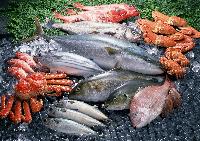Fishing of Madhya Pradesh
- Madhya Pradesh is the largest geographic unit of the country. Except for the valleys of the Narmada and Tapti, Madhya Pradesh is mainly plateau land, with a mean elevation of 488 m above sea level, interspersed with mountains of the Vindhya and the Satpura ranges.
- With an average rainfall of 76 to 150 cm, the State gives birth to four great rivers of the country, viz., Narmada, Tapti, Mahanadi, and Mahi and it also contains sub-catchments of the Ganga, Yamuna, Godavari and Brahmani rivers.
- Rivers originating from the highlands of Madhya Pradesh drain out in three different directions.
- The great Narmada basin with its mainstream runs across the State from east to west, receiving tributaries on either side.
- The rivers Chambal, Betwa and Son descend from the northern slopes of the Vindhyas, feeding the Ganga river system.
- The Mahanadi flows eastwards and the Tapti cuts across the State diagonally in a southwesterly direction to enter the Bay of Bengal.
- The rivers, tributaries, rivulets and streams in the State have a combined legth of 12 000 km.
- During the monsoons, all the rivers in Madhya Pradesh turn into raging torrents, carrying enormous quantities of water.
- During the dry season, they shrink to rivulets.
- Thus, harnessing of water for irrigation and power generation is more relevant in the State, than anywhere else in India and its track record in tapping the water resources has been impressive.
RESERVOIR FISHERIES RESOURCES OF MADHYA PRADESH
- Madhya Pradesh, with its 0.46 million ha of reservoirs, has the maximum waterspread under man-made lakes of all Indian States.
- Gandhisagar reservoir is the second largest reservoir (in area) in the country, next only to the Hirakud of Orissa.
- However, the State is all set to top the table when the proposed Narmadasagar reservoir (91 348 ha) becomes a reality.
- The State Fisheries Department of Madhya Pradesh does not have an account of all man-made water bodies.
- The enumeration is especially poor in respect of the small reservoirs.
- However, the Statistics Wing of the State Fisheries Department maintains records on total area under different categories of inland water bodies by districts.
- The Department has classified the inland water bodies into four size groups, ,
- <10 ha,
- 10 to 500 ha,
- 501 to 1 000 ha
- > 1 000 ha.
- The water bodies less than 10 ha in size are ponds and small tanks which are excluded from the purview of this study.
- The remaining three categories, by and large, comprise man-made impoundments, with very few exceptions.
- Among them, the second and third groups together represent small reservoirs (<1 000 ha), as defined in this study.
- Reservoirs of the fourth group include both medium and large reservoirs.
- Within limitations of the available data, an attempt has been made to separate various categories of impoundments and place them under the present classification.
- The small, medium and large reservoirs in the State are estimated at 172 575, 169 502 and 118 307 ha respectively with a total of 460 384 ha.
- Raipur district with 11 327 ha and Guna with 7 310 ha have the largest areas under small reservoirs, while Narasingpur, (552 ha), Hoshangabad (861 ha) and Khandwa (814 ha) have the least. The five large reservoirs of the State are in Raisen, Mandsaur, Jabalpur, Chindwara and Raipur districts, while 19 districts have medium reservoirs.
- Description of 32 reservoirs comprising 6 small, 21 medium and 5 large, covering a total area of 173 901 ha, is available. The average size of these small, medium and large reservoirs is 350, 2 527 and 23 661 ha respectively.
- Fish production trends are available for 25 reservoirs, 20 of which belong to the medium category.
- The Sarni reservoir (1 012 ha) in the district of Betul, producing 61.95 t of fish (61.21 kg ha-1) is the most productive medium reservoir, followed by Kolar (40.0 kg ha-1) and Maniyari (25.75 kg ha-1). Bhimgarh (0.51 kg ha-1) and Manoharsagar (1.13 kg ha-1) have the poorest yield.
- The three large reservoirs, , the Gandhisagar, Barna and Totladoh for which catch data are 213.4-11.5c23.5-6.3 42-24.2 48.3-47.8 11.4-42.9 11.4-132.3 11.4-132.3s0-89.4-11.4-132.3zm-317.5 213.5V175.2l142.7 81.2-142.7 81.2z"/> Subscribe on YouTube
